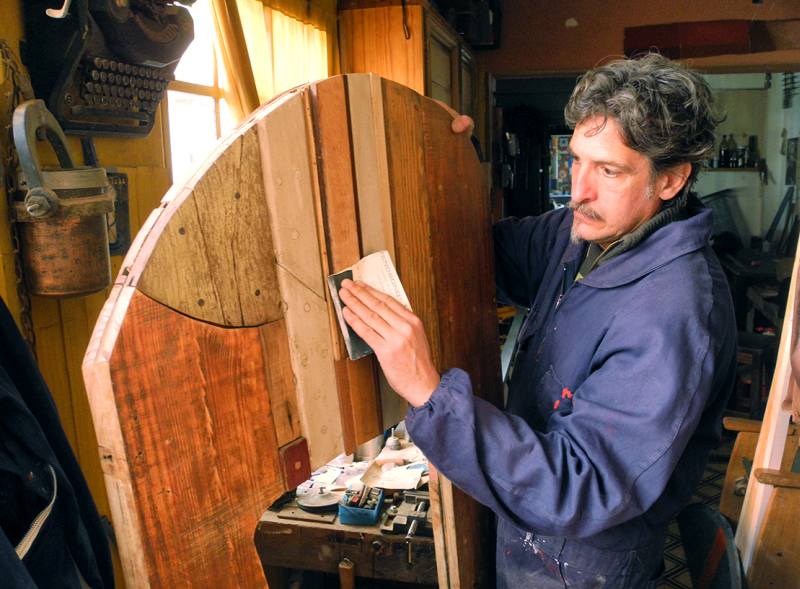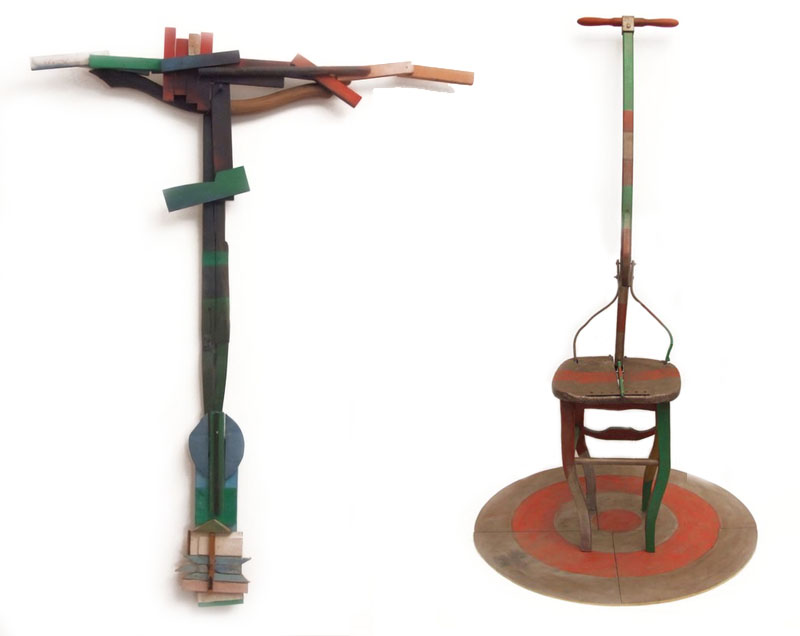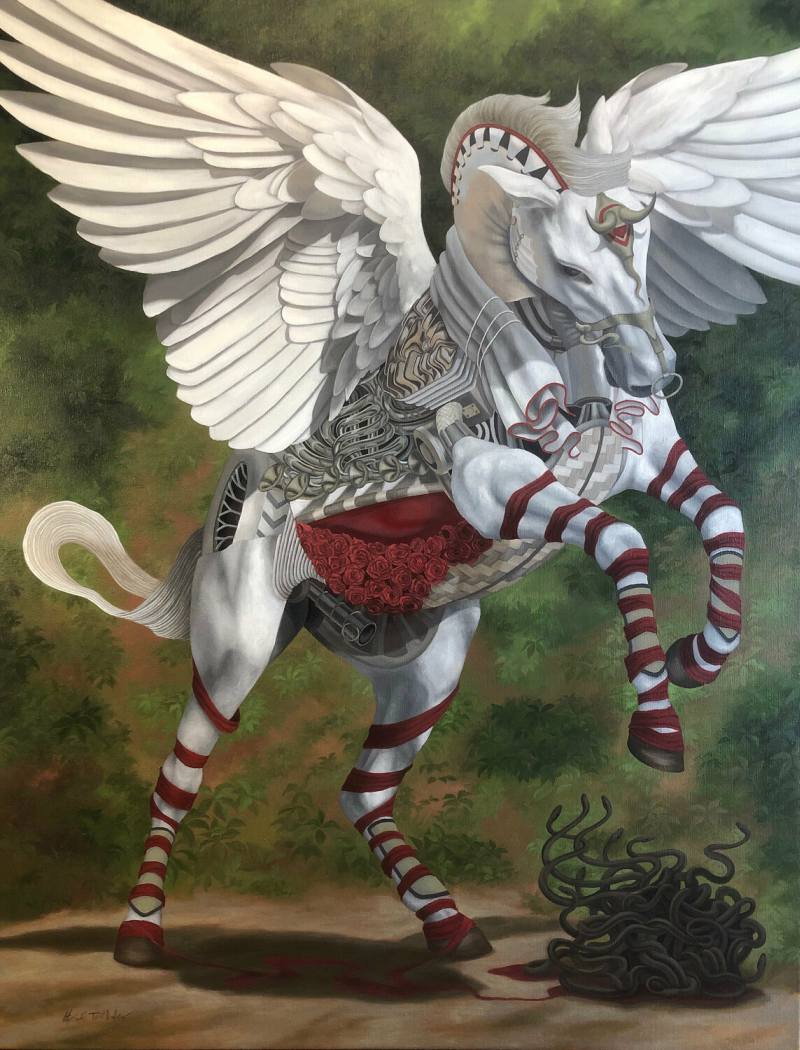Damrong Wong-Uparaj
ดำรง วงศ์อุปราช
(เมืองเชียงราย, ราชอาณาจักรไทย /
Chiang Rai, Tailandia / Thailand, 1936 - 2002)
"Casas tradicionales en Stilts / Traditional Houses on Stilts"
Témpera sobre lienzo / tempera on canvas, 85 x 102 cm., 1962. Bonhams
"Escena costera con botes, rocas y postes tipo andamio /
Shore Scene with Boats, Rocks and Scaffold-Like Poles"
Óleo sobre lienzo / oil on canvas, 79,5 x 147,5 cm., 1961. Christie's
_______________________________________________________________
Bernard Buffet
(París, Francia / France, 1928 - Tourtour, 1999)
"Horreur de la guerre: Les fusillés / El horror de la guerra: Los fusilados /
Horror of War: The Executed", óleo sobre lienzo / oil on canvas, 265 x 600 cm., 1954
© Fonds de dotation Bernard Buffet. Spectacles Selection
Bernard Buffet pintó este tríptico y las veintiséis acuarelas que lo acompañan en 1954; sólo tenía 26 años. Por su excesividad y su ambicioso tema, estos cuadros revelan la aspiración del pintor de marcar su época, como había hecho Picasso con el "Guernica" (1937). Buffet se basa en los grandes ejemplos de la historia del arte para crear sus composiciones: "Las grandes miserias de la guerra" (1633) de Jacques Callot, "Los desastres de la guerra" (1810-20) de Francisco de Goya o incluso "La guerra" (1894) de Douanier Rousseau. Como "pintor testigo de su tiempo", registra las atrocidades de la Segunda Guerra Mundial, pero no sólo eso. Sus escuálidos desnudos no evocan ninguna época, dando un alcance universal a su discurso. En el fondo, sin embargo, están los paisajes de la Alta Provenza que rodean el estudio de Buffet, lo cual, en contacto con Jean Giono, afirmó por primera vez su antimilitarismo. HBDD
"Horreur de la Guerre: L’Ange de la guerre / El horror de la guerra: El ángel de la guerra /
Horror of War: The Angel of War", óleo sobre lienzo / oil on canvas, 265 x 685 cm., 1954
© Fonds de dotation Bernard Buffet. Spectacles Selection
"Horreur de la guerre: Les pendus / El horror de la guerra: Los colgados /
Horror of War: The Hanged", óleo sobre lienzo / oil on canvas, 265 x 685 cm., 1954
© Fonds de dotation Bernard Buffet. Spectacles Selection
Bernard Buffet painted this triptych and the twenty-six watercolors that accompany it in 1954; he was only 26 years old. Through their excessiveness and ambitious theme, these paintings reveal the painter's aspiration to mark his era, as Picasso had done with "Guernica" (1937). Buffet draws on the great examples of art history to create his compositions: Jacques Callot's "Great Miseries of War" (1633), Francisco de Goya's "Disasters of War" (1810-20) or even Douanier Rousseau's "War" (1894). As a "painter witness of his time", he reports the atrocities of the Second World War but not only. His emaciated nudes do not evoke any era, giving a universal scope to his discourse. In the background, however, are the landscapes of Haute-Provence surrounding Buffet's studio, which, in contact with Jean Giono, asserted his anti-militarism for the first time. HBDD
El horror de la guerra. Instalación en el Museo de Arte Moderno /
Horror of War. Installation at he Museum of Modern Art
París, Francia / France, 2017. The Gaze of a Parisienne
Bernard Buffet en "El Hurgador" / in this blog: [Todos los enlaces / All Links]
_______________________________________________________________
Gyula Szabó
(Magyarország / Hungría / Hungary, 1983-)
en / at Budapest
"Nacido / Born", óleo sobre lienzo / oil on canvas, 150 x 240 cm., 2019. facebook
"El hoyo / The Hole", óleo sobre lienzo / oil on canvas, 150 x 200 cm., 2020. Instagram
Thomas Daniel Lowy Elbau
(Montevideo, Uruguay, 1947 - 2020)
Exposición "Por Qué", 25/6 - 19/8/2018 / Exhibition "Why", Jun. 25 - Aug. 19, 2018
Museo de Bellas Artes Juan Manuel Blanes (Montevideo, Uruguay). Catálogo / Catalog
Exposición "Por Qué", 25/6 - 19/8/2018 / Exhibition "Why", Jun. 25 - Aug. 19, 2018
Museo de Bellas Artes Juan Manuel Blanes (Montevideo, Uruguay). Catálogo / Catalog
_______________________________________________________________
Alasdair Gray
(Riddrie, Glasgow, Escocia / Scotland, 1934 - 2019)
"El Edén y después / Eden and After", óleo sobre panel / oil on panel, 62,7 x 55 cm. © Alasdair Gray
National Galeries of Scotland (Glasgow, Escocia / Scotland). Arthur
"Jonás y la ballena / Jonah and the Whale"
Mural en una casa privada / a mural in a private house, 1961 © Alasdair Gray. Link
"Paisaje de las calles de Cowcaddens en los '50 / Cowcaddens Streetscape in the Fifties", 1964
© Alasdair Gray. Link
_______________________________________________________________
Bhupen Khakhar
भूपेन खखर
(मुंबई, ভারতীয় প্রজাতন্ত্র / Bombay / Mumbai, India, 1934 -
वडोदरा / Vadodara [Baroda], 2003)
"No puedes complacer a todos / You Can’t Please All"
Óleo sobre lienzo / oil on canvas, 175,6 × 175,6 cm., 1981
Tate Gallery (Londres, Reino Unido / London, UK)
Bhupen Khakhar en "El Hurgador" / in this blog: [Recolección (LXVIII)]
_______________________________________________________________
Satish Gujral
ਸਤੀਸ਼ ਗੁਜਰਾਲ
(پاكِستان, جہلم / Jhelum [Jehlum], Pakistán, 1925 -
नई दिल्ली, ভারতীয় প্রজাতন্ত্র, Nueva Delhi / New Delhi, India, 2020)
"La bella y la bestia / Beauty and the Beast"
Tinta y collage sobre cartón montado sobre panel /
ink and paper collage on cardboard laid on board, 73,9 x 49,8 cm., 1968. Sotheby's
Más sobre / More about Satish Gujral: Website, Wikipedia (English)
_______________________________________________________________
Abdoulaye Diarrassouba "Aboudia"
(Côte d'Ivoire / Costa de Marfil / Ivory Coast, 1983-)
"Le petit chien rouge / El perrito rojo / The Little Red Dog"
Acrílico y pastel al óleo sobre tela / acrylic and oil pastels on canvas, 150 x 150 cm., 2018. Out of Africa
"Les trois amis III / Los tres amigos III / Three Friends III"
Acrílico y pastel al óleo sobre tela / acrylic and oil pastels on canvas, 150 x 150 cm., 2018. Out of Africa
_______________________________________________________________
Gert & Uwe Tobias
(Braşov, România / Rumania / Romania, 1973-)
"Sin título / Untitled"
Xilografía a color sobre papel / colored woodcut on paper, 200,5 x 301 cm., 2011. Phillips
"Sin título / Untitled"
Xilografía a color sobre papel / colored woodcut on paper, 168 x 150 cm., 2011. Phillips
_______________________________________________________________
Miquel Barceló
(Felanich, Islas Baleares, España / Balearic Islands, Spain, 1957-)
"Mapa de carn / Mapa de carne / Map of Flesh"
Pigmentos y látex sobre tela / pigments and latex on canvas, 195 x 345 cm., 1982
© Miquel Barceló, VEGAP, Barcelona, 2021
Colección de arte contemporáneo Fundación La Caixa
Miquel Barceló en "El Hurgador" / in this blog: [Rinocerontes (XXXI)], [Asonancias (VI)]
_______________________________________________________________
Bruce Obomeyoma Onobrakpeya
(Nàìjíríà / Nigeria, 1932-)
"Ekube / Unidad / Unity", óleo sobre lienzo / oil on canvas, 203 x 139 cm., 1995. Bonhams
"Estudios para Ekube II / Studies for Ekube II"
Óleo sobre lienzo laminado / oil on laminated canvas, 117,5 x 92 cm., 1994/2012. Bonhams
_______________________________________________________________
Abas Alibasyah
(Purwakarta, Jawa Barat / Java Occidental / West Java, Indonesia, 1928-)
"Bailarín tribal / Tribal Dancer", óleo sobre lienzo / oil on canvas, 82,5 x 59 cm., 1965. Sotheby's
"Figura de una bailarina / Figure of Dancer"
Óleo sobre lienzo / oil on canvas, 70 x 80 cm., 1991. Lofty
"Garuda", óleo sobre lienzo / oil on canvas, 100 x 66 cm., 1969
Galeri Nasional Indonesia (Jakarta, Indonesia)
Abas Alibasyah en "El Hurgador" / in this blog: [Recolección (CXLVII-2)]

































































